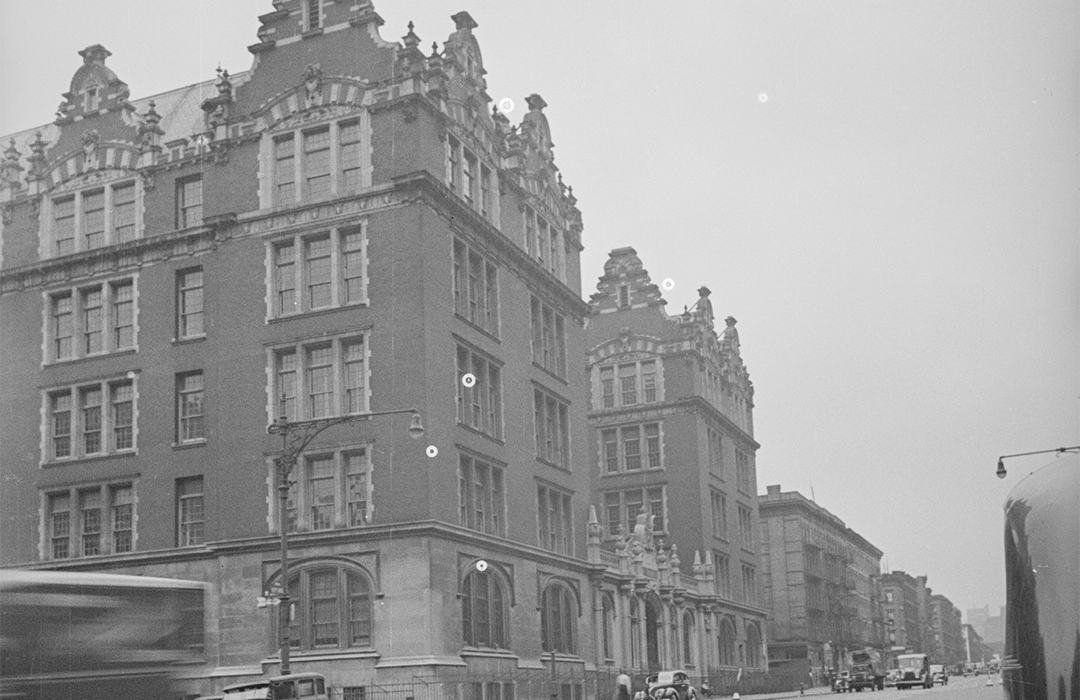
Dewitt Clinton High School: 899 10th Ave.
by Tom Miller
During the meeting of the Board of Education on February 25, 1903, Commissioner William Lummis protested, “It is a criminal waste of the city’s money and a monument to the ill-judgment of those who knowingly vote for it.” Lummis was referring to the imminent vote to erect the DeWitt Clinton High School (often spelled “De Witt”) on the western blockfront of Tenth Avenue between 58th and 59th Streets. The property had sat stagnant since the city paid $271,000 for it six years earlier. Lummis called the setting, according to The New York Times, “of the most distasteful and obnoxious kind.”
Despite Lummis’s arguments, the board voted in favor of the site. Two days later, The New York Times reported that the Superintendent of School Buildings, Charles B. J. Snyder, ‘will be for the next two weeks busy…with the plans and specifications for the new De Witt Clinton High School.” Starting out as the Boys’ High School in 1897 sharing space in Public School 35 on West 13th Street, it had grown exponentially. The article mentioned, “The present De Witt Clinton High School is at 140 West One Hundred and Second Street, with annexes in West Thirteenth Street, East Twenty-third Street, and West Forty-sixth Street.”
The plans were approved in May. The New York Times said, “It will accommodate nearly 4,000 students, the auditorium alone having a seating capacity for about 2,600 persons.” The article said the architecture would be “somewhat after the style of the Flemish Renaissance, with large gables and dormers on the various fronts, covered by high-pitched roofs.” The base would be clad in limestone, the upper portion in red brick and trimmed with terra cotta. The newspaper reported, “The Tenth Avenue entrance “will be approached through a large logia [sic], or covered porch.’ The dramatic loggia would connect the south and north wings that created a paved courtyard. Snyder configured the building in his signature “H-plan,” which provided the optimum amount of ventilation and light. A poignant detail Snyder included were sculpted, full-figure owls—the symbol of wisdom and knowledge–on either side of the main entrance. Below each was a nest of owlets, signifying learning.
In the evenings, the auditorium was often the venue for public lectures, meetings, and presentations…
The DeWitt Clinton High School would be unique among Manhattan school buildings in at least one respect—it would be the first to have mural decoration. The two works, on either side of the platform in the auditorium by Charles Y. Turner, would represent The Opening of the Erie Canal and The Marriage of the Waters of the Great Lakes with the Sea. Both were important events during Clinton’s governorship.
Construction was completed in time for the 1906 school season. Like other school buildings throughout the city, its usefulness did not end at the closing bell. In the evenings, the auditorium was often the venue for public lectures, meetings, and presentations, and certain classrooms were used as the New York Free Evening School.
The DeWitt Clinton High School offered extracurricular groups other than athletics. As early as 1911, it had an Aero Club; on May 15, 1920, the Spanish Department staged the Spanish-language musical Velada in the auditorium, accompanied by “the well-known DeWitt Clinton orchestra,” according to Bulletin of High Points; and by 1924 the Italian Club, Circolo Italiano, was publishing its magazine, Il Foro.
Many of the DeWitt Clinton High School graduates achieved celebrity in their fields. Among the 1918 graduating class was Edward Weinfeld. After holding high-ranking State positions, including Commissioner of Housing from 1939 to 1942, he was nominated by President Harry S. Truman in 1950 to a seat on the United States District Court for the Southern District of New York.
Another judge to graduate from DeWitt Clinton was Isidore Kaufman, who enrolled at the age of 12 in 1922. He became a United States circuit judge and a United States district judge of the United States Court of Appeals, his latter nomination made by President John F. Kennedy. Kaufman’s most memorable case was that of the espionage trial of Julius and Ethel Rosenberg in 1951.
When Bernard Herrmann began here in the fall of 1927, Burton Lancaster was already a standout among his classmates. Lancaster was a basketball star and an accomplished gymnast. Bernard Herrmann went on to become one of the best-known film composers, winning an Academy Award for The Devil and Daniel Webster. Burt Lancaster also went to Hollywood, of course, becoming a leading man and being nominated for four Academy Awards for Best Actor, winning once.
In the meantime, in its December 1920 issue, Bulletin of High Points reported, “On September 13, 1920, the Haaren High School was opened to take care of the co-operative work which had been scattered, up to this time, in eleven different high schools of the city.” The fourth and fifth floors of P. S. 44 downtown had been set aside for the school. “The school is offering commercial courses in office work and selling at the main building and shopwork at the Manual Training annex,” said the article. The New York Legislative Documents of 1923 explained that the school was “organized on a dual basis to afford pupils an opportunity to acquire a secondary education of high school rank and also to secure apprenticeship training in a commercial field.”
In 1929, DeWitt Clinton High School moved into its new campus in the Bronx. Esteemed architect Mott B. Schmidt was commissioned to renovate the interior for Haaren High School. It was not especially long before the difference in personalities of the two institutions was apparent.
On July 15, 1943, 17-year-old George Mihalopoulos appeared before Judge James M. Barrett to be sentenced on charges of second-degree robbery. Mihalopoulos, on May 11, had entered a Bronx drugstore, locked the door behind him, and, while wielding a “large wrench,” demanded morphine from the druggist, Morris Kassen. On the way out of the store, he grabbed $30 from the cash register. A policeman nabbed him only a few yards from the drugstore.
The teen explained to Judge Barrett that he had been driven to crime six months ago when a man “came around to Haaren High School to sell marihuana cigarettes to the kids.” The ploy worked. Barrett said, “that but for this George would be sentenced to a term at Sing Sing, but that instead he would be sent to Elmira Reformatory,” as reported by The Daily Gleaner, of New Brunswick, Canada.
Harren High School was shuttered by 1980.
On the night of June 27, 1965, 800 students gathered in the auditorium to listen to music, “interrupted periodically and briefly by educators, social workers and a priest exhorting them to stay in school,” reported the Daily News. Journalist Peter Coutros said, “For one reason or another—and the reasons are plentiful—most of the youngsters in Haaren High that night won’t ever get to a prom. The odds are very strong against their even finishing high school.”
Two years later, motion picture scouts looked for “an authentic location for filming a violent, fear-ridden school script, they found New York’s Haaren High School as the ideal setting,” according to The Monitor News Service. The 1967 Up The Down Staircase was filmed within the building.
But innovative programs that would change the environment were coming. On August 19, 1974, the Newark Advocate said, “Today, a visitor can walk up the ‘down’ staircase at Haaren in safety.” The principal, Bernard V. Deutchman, remarked, “Haaren High School is a different place today. Learning is taking place.”
Despite that, Haaren High School was shuttered by 1980. It was renovated to Metropolis Studios, where the television series Fame, for instance, was shot. On April 22, 1982, Newsday reported, “Where students once stared out windows, smoked in the bathrooms and dissected frogs, moviemakers will now shoot television shows, act out soap operas and produce films with the newest state-of-the-art technology—electronic cinema.”
The building returned to educational purposes the following decade. The John Jay College of Criminal Justice acquired the property in 1997 and commissioned Rafael Viñoly Architects to remodel and expand the building to the rear. The school offers courses in criminal justice, forensic science, and public service. Of the more than 700 school buildings Charles B. J. Snyder designed, the former DeWitt Clinton High School is among the most striking.
Tom Miller is a social historian and blogger at daytoninmanhattan.blogspot.com


